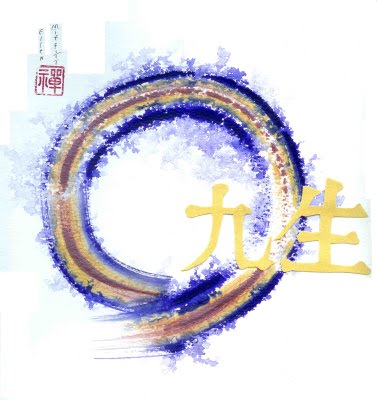Someone recently asked what's with my use of Eco Collage - recycling actually has always been the mainstay of the media since collage is generally an art form that uses bits of this & that to create a design. The following list shows the common types of collage and typical materials used in each form.
TYPES of COLLAGE
AFFICHES LACERES (a-fisn lah-ser-ay') Found paper collage
ASSEMBLAGE (ah-se m-blah'j) Combination of three-dimensional objects glued to a surface
BRICOLAGE (bree-col-ah'j) Combining odds and ends in collage
BRULAGE (brew-lah'j) Burning of dampened collage materials
COLLAGE (ko-lah'j) Pasting or gluing papers or objects onto a surface
DECALCOMANIE (day-kal-k6-mahn-ee) Placing wet paint between two surfaces and pulling apart
DECHIRAGE (day-shur-ah'j) Distressed paper collage
DECOLLAGE (day-ko-lah'j) Removing, un-gluing or otherwise subtracting material from the layers of a collage
DECOUPAGE (day-koop-ah'j) Cut paper collage
FEMMAGE (fahm-ah'j) Collage art and traditional craft done by women, frequently fabric-oriented
FROISSAGE (fwahs-ajh') Crumpling or creasing of collage materials
FROTTAGE (frot-ah'j) Rubbing a design onto collage materials from a textured surface
FUMAGE (foom-ah'j) Exposing dampened collage materials or surface to candle smoke
LAYERING (lay-r-ing) Building and removing layers of collage materials; a philosophy of connecting spiritual energies with art
MIXED MEDIA COLLAGE Any combination of media with. collage
PAPIERS COLLES (pah-peecay ko-lay)Pasted papers
PHOTOMONTAGE: 'Collage of glued photographs or Cut out photos
As you see from the list of types of collage, this art form has always been about reusing various found objects, papers, etc. There seems to be a new movement in art to incorporate recycled or discarded materials to make "green" pieces.
My Eco Statement follows:
In today's era of heightened environmental awareness, artists are increasingly turning to junk stores, trash bins and surplus outlets to satisfy their urge to create. Every time I go to place something into my trash bag, I take a second look and ask myself how can I use that creatively in a collage? What most people would causally toss, I select for potential inclusion. It can be anything from jar lids, coffee filters, onion skin, onion bags, broken toys, split open tubes of dried paint, paper doilies, broken costume jewelry... The challenge for me is taking things that are destined for the landfill and integrating them into my art.
The use of everyday objects in art can be traced to American folk art in the 19th and 20th centuries; to the Dada movement in Zurich, Barcelona and New York in the 1910s and early 1920s; and most recently to the work of Alexander Calder, Joseph Cornell, John Chamberlain and Louise Nevelson, among others.
Creative recycling into artwork shows my green side and my effort in caring for the planet. I reuse my sumi-e practice papers by staining them or turn scrap paper into "new" handmade paper; save bits and pieces of miscellaneous junk; and the resulting collages reflect the Zen concepts of harmony and balance that I strive to exemplify.
Friday, December 5, 2008
Subscribe to:
Post Comments (Atom)





No comments:
Post a Comment